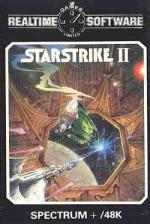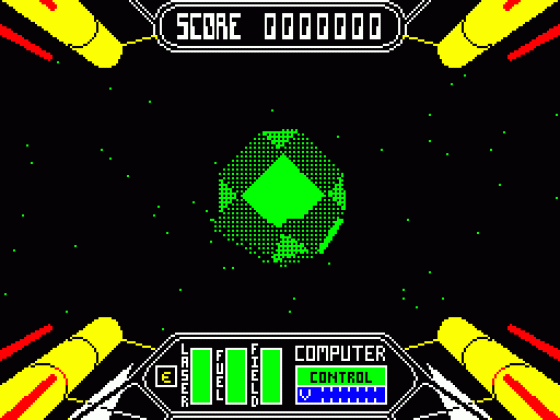
ZX Computing
 1st June 1986
1st June 1986
Categories: Review: Software
Publisher: Realtime
Machine: Spectrum 48K
Published in ZX Computing #26
Starstrike II
Realtime have discovered 'shaded graphics' on some faraway planet and brought them back for Starstrike II
Space - the final frontier. These are the voyages of the star ship Starstrike. Its ongoing mission; to seek out as many spaceships as you can find and blast them all into tiny little bits.
Starstrike II, the sequel, believe it or not, to Starstrike, is another of the 3D space shoot-'em-ups following in the wake of Elite. What you think of this particular game probably depends very much on how you like your shoot-'em-ups. If you like them to be a straightforward series of showdowns between yourself and endless enemy spacecraft then you're probably going to lie this. If, on the other hand, you liked the added non-violent elements that Elite contained in the interplanetary wheeling and dealing aspects then you might find Strike II a bit monotonous.

As the pilot of the Starstrike II vessel it is your task to lead the forces of the Federation into the planetary systems occupied by your enemies. The Outsiders. Their 22 home planets are grouped around five stars in The Lesser Magellanic Cloud, and fall into three categories: Agricultural, Industrial and Military.
All of these planets have their layers of defences in the form of ground defenders, orbital fighters and planetary defence fields, whilst some of the industrial and all of the military planets have space stations that you must get past. As in Elite, there is a docking sequence involving these space stations, but once successfully docked you can go straight into the next phase of the planetary defences - there is no trading element involved.
In order to successfully neutralise each planet you must get past its defences and locate either a battle computer, reactor or control computer before moving on to the next planet or star system.
Your own craft is armed with a laser which is aimed by using a set of crosswires. Other controls are fairly simple: there are three on-screen displays showing the status of your laser, fuel and force field, and when in space there are two displays, again similar to those in Elite, which help you to locate enemy craft and fuel supplies. Navigation controls are Up, Down, Left, Right and Accelerate/Decelerate, and while joystick control was perfectly okay I found that the choice of keyboard controls was rather awkward and it would have been nice if these could have been redefined.
In some ways, Starstrike II is an improvement upon Elite and some of its clones because the programmers at Realtime have managed to take the graphics a step further than in any other games of this sort. Instead of drawing all the spacecraft in simple outlines, Starstrike II uses solid, shaded graphics which enhance the 3D effect and give a greater appearance of depth to many of the scenes in the game. But the improvement in graphics has clearly taken its toll on the power of the Spectrum and other elements of the game suffer as a result. Sound is totally lacking throughout the game, and though many people find the Spectrum's beep irritating I found the silence a bit boring.
The increased complexity of the graphics give the Spectrum a lot more work to do, and the speed of movement of both your own and the enemy craft is a bit slower than in most similar games. This didn't really affect the enemy craft, which still moved too fast for me to catch most of them, but it does seem to affect the responsiveness of your own craft a bit. Even so, I prefer this to most of the recent space combat games, and though I still think that Elite sets the standard it should be mentioned that Starstrike II costs some £7 less than that game and is therefore likely to be within the price range of a lot more people.
Other Reviews Of Starstrike 2 For The Spectrum 48K
Starstrike II (Realtime)
A review by (Crash)
Starstrike II (Realtime)
A review by Phil South (Your Sinclair)
Starstrike II (Realtime/Firebird)
A review by Jerry Muir (Sinclair User)
Starstrike II (Realtime)
A review
Star Strike II (Realtime)
A review



